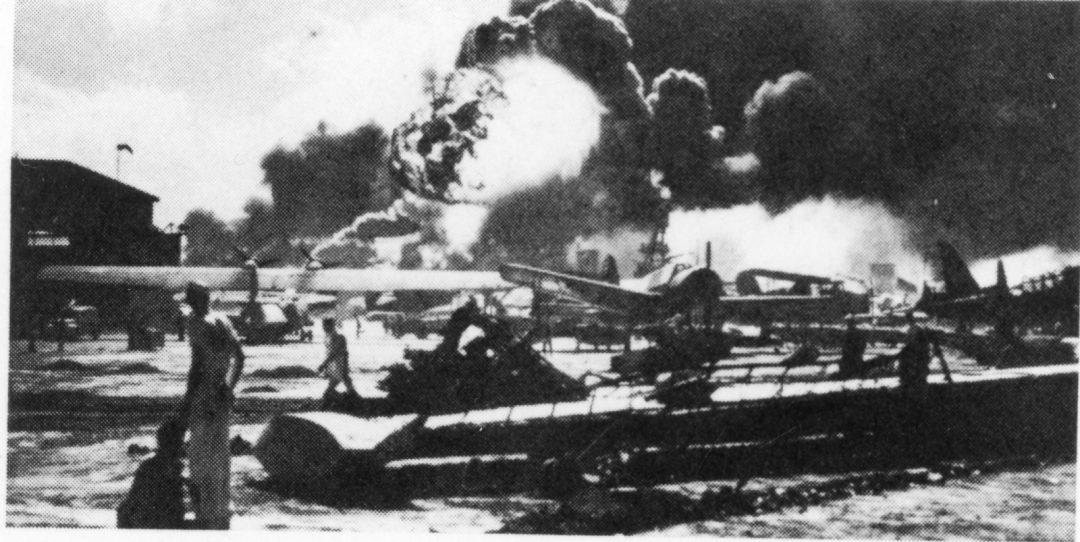To understand the significance of the historical photograph of Pearl Harbor, Hawaii 1941 SDASM, it is essential to have a background on the attack and its impact on American history. Pearl Harbor took place on December 7, 1941, when the Imperial Japanese Navy Air Service launched a surprise military strike against the United States naval base at Pearl Harbor in Hawaii. The attack began early in the morning and resulted in severe devastation. Japan’s motive for such an attack was to cripple the United States Navy to prevent interference with Japan’s plans to expand its territory in Southeast Asia amid World War II.[1] This expansion was driven by Japan’s ambitions for regional dominance and access to crucial natural resources. The casualty count recorded was 2,403 deceased and 1,178 wounded. Damage included the sinking of three United States battleships, the Arizona, West Virginia, and California, along with major damage to the Tennessee, Nevada, Maryland, and Pennsylvania, and the capsizing of the Oklahoma.[2] The attack on Pearl Harbor was a pivotal moment that mobilized the United States, shifting public opinion from isolationism to active involvement in World War II. On December 8, 1941, President Franklin D. Roosevelt famously addressed Congress, calling the attack a date “which will live in infamy.” (Theodore A. Wilson, 2023).[3] Congress immediately declared war on Japan, officially bringing the United States of America into World War II. The United States’ entry into World War II marked a turning point in the global conflict, significantly contributing to the Allied powers’ eventual victory.[4] The attack left a legacy, remembered for its sudden and devastating nature, and influenced U.S. military strategy, policy, and public perception of national security. Pearl Harbor is commemorated annually and serves as a reminder of the vulnerability of even the most powerful nations.
This photograph is part of the San Diego Air and Space Museum Archives’ collection, which preserves and provides insights into significant events in aviation and military history. The image, likely captured during or immediately after the attack, visually documents the devastation at Pearl Harbor. It depicts burning ships, thick smoke billowing into the sky, and scenes of destruction in the harbor, emphasizing the suddenness and brutality of the assault. The raw intensity of the photograph captures the chaos and urgency of that morning, making it a powerful piece of historical documentation. The visual composition of contrasting dark smoke with the brightness of explosions and fire ultimately evokes themes of violence, vulnerability, and the moment’s desperation. The SDASM photograph stands out because it captures both the physical devastation and the emotional weight of the attack in a single, cohesive scene. Its dramatic interplay of light and shadow, combined with its holistic portrayal of the harbor, makes it not only a document of historical fact but also a profoundly evocative symbol of the chaos and vulnerability experienced on that fateful day.
Photographs like this one were essential in rallying public support for the war effort, reinforcing narratives of an unprovoked attack on American soil. The dramatic imagery, paired with its emotional impact, was used in newspapers, posters, and other media to unite Americans and strengthen their resolve to engage in World War II. This image, along with others documenting Pearl Harbor, became a symbol of American resilience and the justification for full engagement in the war. While it served as documentation, its selection for public display was influenced by its ability to evoke strong emotions of anger and determination.
Today, archival images like the Pearl Harbor, Hawaii 1941 SDASM photograph are used as both historical documentation and a reminder of the narratives they supported during the war. Modern audiences view these photographs with reverence for their factual content and an awareness of the role they played in shaping public opinion and wartime policy. The preservation and presentation of these images contribute to the collective memory of World War II, highlighting the powerful intersection of historical documentation and public sentiment. Archival sources ensure future generations can reflect on the significance of Pearl Harbor and its profound influence on U.S. history and military policy.
[1] Gompert, David C., Hans Binnendijk, and Bonny Lin. “Japan’s Attack on Pearl Harbor, 1941.” In Blinders, Blunders, and Wars: What America and China Can Learn, 93–106. RAND Corporation, 2014. http://www.jstor.org/stable/10.7249/j.ctt1287m9t.15. Pg. 16
[2] Wilson, Theodore A., and Kenneth William Townsend. 2023. “Bombing of Pearl Harbor.” Salem Press Encyclopedia, January. https://research.ebsco.com/linkprocessor/plink?id=55c6a87c-7b67-340c-9c73-a79ded7940d7.
[3] Wilson, Theodore A., and Kenneth William Townsend. 2023. “Bombing of Pearl Harbor.” Salem Press Encyclopedia, January. https://research.ebsco.com/linkprocessor/plink?id=55c6a87c-7b67-340c-9c73-a79ded7940d7.
[4] Pruitt, Sarah. “After Pearl Harbor: The Race to Save the U.S. Fleet.” HISTORY. A&E Television Networks. Last modified December 6, 2019. Originally published December 1, 2016. https://www.history.com/news/after-pearl-harbor-the-race-to-save-the-u-s-fleet. Accessed November 4, 2024.
Image Citation: Wikimedia Commons contributors, “File:86116781 Pearl Harbor, Hawaii 1941 SDASM Image.jpg,” Wikimedia Commons,https://commons.wikimedia.org/w/index.php?title=File:86116781_Pearl_Harbor,_Hawaii_1941_SDASM_Image.jpg&oldid=906809643 (accessed December 3, 2024).
